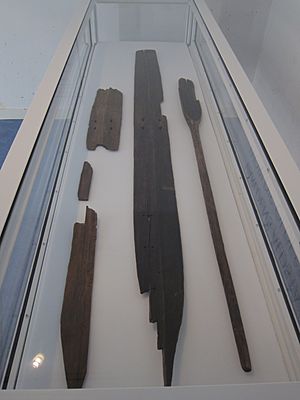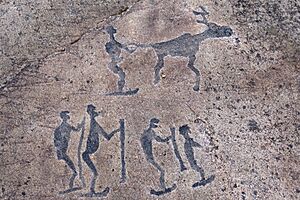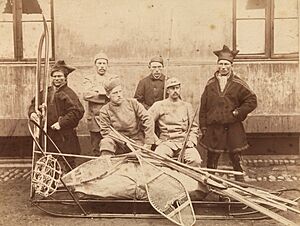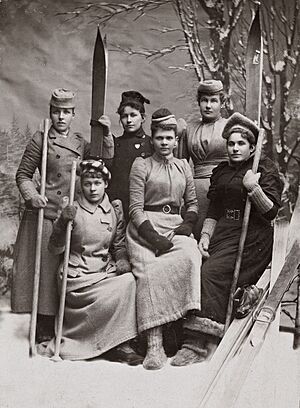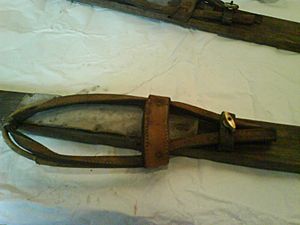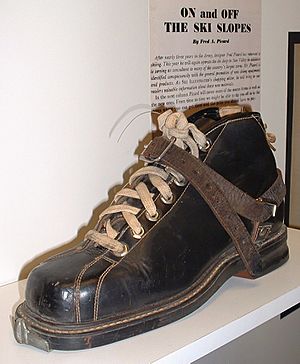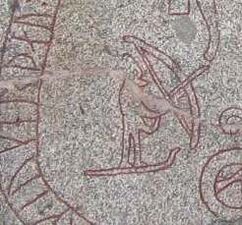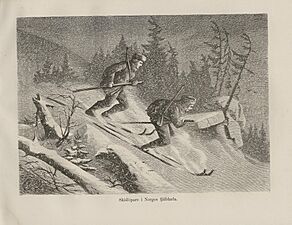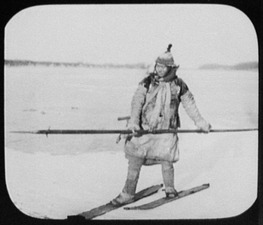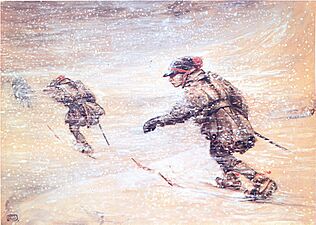History of skiing facts for kids
Skiing, which is traveling over snow using skis, has been around for at least 8,000 years! The very first skis ever found were in Karelia, a region in western Russia, and they are about 8,000 years old.
Even though skiing started as a way to get around and hunt, the modern sport we know today began in Scandinavia (countries like Norway and Sweden) in the mid-1800s. Since then, skiing has become a popular fun activity and sport all over the world, leading to the creation of ski resorts and towns built around them.
What "Ski" Means
The word ski comes from an old language called Old Norse. In Old Norse, skíð meant "cleft wood," "stick of wood," or "ski." People in Old Norse would say things like fara á skíðum to mean "to travel fast on skis."
Today, in languages like English, we say "to ski." In French, it's skier, and in Spanish, it's esquiar. But in modern Norwegian and Swedish, they don't make a verb from the word "ski."
Finnish and Estonian languages have their own old words for skis and skiing. For example, in Finnish, "ski" is suksi and "skiing" is hiihtää. The Sami people, who live in northern Europe, also have their own words, like sabek for "ski" and cuoigat for "to ski."
Ancient Ski Discoveries
The oldest information we have about skiing comes from things archaeologists have found. The earliest evidence of skis comes from two main areas:
- Northern Russia: The oldest pieces of ski-like objects were found near Lake Sindor, about 1,200 km northeast of Moscow. They are from around 6300 to 5000 BCE.
- China: In the Altaic region of modern China, there are 5,000-year-old paintings that might show people using skis. However, experts are still discussing this.
Skiers in Rock Art
The earliest pictures of skiing in Scandinavia are from 3000 or 4000 BCE. These are simple carvings on rocks. One carving in Norway shows a skier holding a single pole or an axe with both hands. Another carving from Norway, around 1000 or 500 BCE, shows a skier getting ready to shoot with a bow and arrow.
Near the White Sea in Russia, rock carvings were found in 1926 that are from 2000 or 2500 BCE. One of these carvings shows hunters on skis hunting large animals. It looks like they used their bows and spears as poles.
Some 5,000-year-old wall paintings in the Xinjiang region of China also suggest that skiing developed there separately among the Tuvan people. But this is still a topic of debate among experts.
Old Ski Finds
The first ancient Scandinavian ski was found in a swamp in Sweden. It dates back to 4500 or 2500 BCE. In 1938, a ski found in Finland was dated to 3245 BCE. Other famous examples include the Kalvträskskidan ski from Sweden (3300 BCE) and the Vefsn ski from Norway (3200 BCE).
More than 20 old, well-preserved skis have been found in drained swamps in Norway. This shows that skis were widely used there, especially in Northern Norway, since ancient times. Skis have even been found in old graves.
In 2014, a ski with leather bindings was found in a melting glacier in Norway. This ski is about 1,300 years old! Many old items have been kept safe for thousands of years by the stable glaciers in Norway and appear when the ice melts.
In 2021, another well-preserved ski, about 187 cm long, was found near a shrinking glacier in Norway. It's also estimated to be 1,300 years old. A ski found in 2014 at the same spot is thought to be its match, making them the world's oldest complete pair of skis! They are made of birch wood and have leather bindings.
Ancient Writings About Skiing
The earliest known writings that mention skiing are from a Chinese scholar who lived between 206 BCE and 225 BCE. He wrote about people who skied in the Altai Mountains. Another old text about skiing was written by a Byzantine scholar named Procopius in the 6th century CE. He described people he called the "scrithiphinnoi," which means "sliding Sami."
Skiing for Travel and War
In Norse mythology, the gods Ullr and Skaði are described as hunting on skis. They are now seen as the god and goddess of skiing and hunting.
Early historical records show that the Sami people were called skrithiphinoi, meaning "ski running Sami." Some experts believe the Sami people have been skiing for over 6,000 years, based on their very old word čuoigat for skiing.
Around 950 CE, a saga (an old Norse story) tells how King Haakon the Good sent his tax collectors out on skis. A law from 1274 stated that "No moose shall be disturbed by skiers on private land."
The saga of King Sverre of Norway says that around 1200, Sverre sent troops on skis to patrol the area near Oslo. During a siege, soldiers even skied down a steep cliff! In 1206, baby Haakon IV of Norway was carried by soldiers on skis through the mountains. This event inspired the modern-day Birkebeinerrennet ski marathon.
Ski warfare, where soldiers use skis, was first written about in the 13th century. Ski troops can move as fast and far as light cavalry (soldiers on horseback). In 1555, a Swedish writer described skiers and their climbing skins in Norway. The army in Trondheim, Norway, used skis from at least 1675, and the Danish-Norwegian army had special skiing battalions from 1747.
In 1799, a French traveler named Jacques de la Tocnaye visited Norway and wrote in his diary about how quickly mail was transported over mountains by a man on "snow skates." He thought it was a very convenient and cheap way to travel.
Norwegian immigrants used skis (which they called "Norwegian snowshoes") in the US Midwest starting around 1836. A Norwegian immigrant known as "Snowshoe Thompson" delivered mail by skiing across the Sierra Nevada mountains between California and Nevada from 1856.
In 1888, Norwegian explorer Fridtjof Nansen and his team crossed the Greenland icecap on skis. In 1910, Roald Amundsen used skis on his famous South Pole Expedition. Skiing was even introduced to Japan in 1902 by the Norwegian consul in Kobe, after Japanese soldiers died in snowstorms.
Skiing as a Sport
The first organized skiing exercises and races were for military training in Norway and Sweden. For example, military ski exercises in 1767 included skiing downhill in rough areas, shooting targets while skiing, and cross-country skiing with a full backpack.
The word "slalom" comes from Norway. In the 1800s, skiers in Telemark, Norway, would challenge each other on "wild slopes" (ville låmir). These races were on difficult trails, often starting from a steep mountain and ending with a sharp turn called the "Telemark turn."
Here are some key moments in skiing sport history:
- 1809: Olaf Rye was the first known ski jumper.
- 1843: The first public skiing competition was held in Tromsø, Norway.
- 1861: The first ski clubs were formed in Norway, California, and Australia. Ski racing became an organized sport in America.
- 1862: The first public ski jumping competition was held in Trysil, Norway. Judges even gave points for style!
- 1878: Skis were shown at a big exhibition in Paris, France, and many were bought by visitors.
- 1879: The word "slalom" was used for the first time.
- 1904: The first ski race in Italy took place.
- 1922: The famous Vasaloppet cross-country ski race started in Sweden. Arnold Lunn created modern slalom competitive skiing.
- 1924: The International Ski Federation (FIS) was formed, and the first Winter Olympics were held.
- 1936: Downhill racing was included in the Winter Olympics.
- 1950: Giant Slalom was officially added to alpine events.
- 1952: Women's Nordic skiing was included in the Winter Olympics for the first time.
- 1957: Doug Pfeiffer created modern freestyle skiing.
- 1992: Mogul skiing and freestyle skiing were added to the Winter Olympics.
- 2009: A campaign to include women's ski jumping led to it being added to the 2014 Winter Olympics.
Skiing for Fun
Skiing also became a popular recreational activity:
- 1820: A newspaper in Oslo, Norway, advertised skis for sale.
- 1849: The first public "ski tour" was organized in Trondheim, Norway.
- 1868: Mountain resorts became popular when city people could reach them by train in winter.
- 1895: The first yearly "ski book" was released in Norway.
- 1908: Ski vacations started being advertised in England.
- 1910: The first rope tow for skiers was introduced.
- 1923: A museum dedicated to skiing opened in Norway.
- 1936: The first chair lift was introduced at Sun Valley, Idaho, USA.
- 1939: The "Sno-Surf" was patented in the USA. It was an early version of a snowboard.
- 1952: The first big commercial snow-making machines were installed in New York, USA.
- 1970s: Telemark skiing, an older style, became popular again.
How Ski Equipment Changed
Skis
For a long time, people used asymmetrical skis, meaning one ski was longer than the other. This was common in northern Finland and Sweden until the 1930s. The longer ski was for sliding, and the shorter one was for pushing off. The bottom of the short ski was sometimes covered with animal skin to help with pushing.
Around 1850, skilled workers in Telemark, Norway, invented the cambered ski. This ski arches up in the middle, under your foot. This design helps spread your weight evenly along the ski. Earlier skis were just flat planks and had to be very thick so they wouldn't bend too much in the snow. The Telemark ski was also the first to have a "sidecut," meaning it was narrower under the foot and wider at the tip and tail. This made it much easier to turn.
In 1950, Howard Head introduced the Head Standard ski, which was made by putting aluminum alloy around a wood core. It also had steel edges, which were invented in Austria in 1928. These skis were very successful because they were designed for people skiing for fun, not just for racing.
By the late 1960s, fiberglass skis mostly replaced aluminum ones. In 1993, Elan introduced the Elan SCX, which had a new shape with a much wider tip and tail than the middle. This design made it much easier for skis to bend into a curve and "carve" a turn. Other companies quickly copied this design, and it changed skiing forever!
Bindings
In the very early days, ski bindings were like those on snowshoes, usually just a leather strap over the toe of the boot. As skiing became a sport, the toe strap was replaced by a metal clip under the toe. This held the boot much more firmly. The heel strap also changed, with a spring added to let the heel lift up more easily.
Later, a metal cable replaced the buckled strap. This cable binding became very popular as cross-country skiing grew. The Rottefella binding, introduced in 1927, was a big change. It got rid of the heel strap by using small holes in the boot sole that fit onto pins in the toe piece. This became the "3-pin system" and was widely used until the 1970s.
When ski lifts were invented in 1908, alpine (downhill) skiing really took off. Skiers no longer had to walk up hills. This meant they didn't need bindings that allowed the heel to unclip for walking. So, the ski world split into cross-country and downhill skiing.
In 1937, Hjalmar Hvam invented the Saf-Ski toe binding, which was designed to release the boot during a fall to prevent injuries.
Boots
At first, ski boots were just regular leather winter boots held to the skis with leather straps. As skiing became more specialized, ski boots also became more specific for either alpine or cross-country skiing.
Modern skiing used to involve going uphill, downhill, and cross-country. When cable bindings were introduced, boots changed too. They often had a special shape at the heel for the cable to latch onto.
With ski lifts, skiers didn't need to walk uphill as much. This led to the development of much stiffer boots, which gave skiers better control when going downhill.
Glide and Grip
The first known advice for ski wax was given in 1673. It suggested using pine tar pitch and rosin. Ski waxing was also written about in 1761.
In 1934, some solid aluminum skis were made in France. Wax didn't stick to aluminum, so these skis had grips under the foot to prevent sliding backward. This was an early version of today's "waxless" skis with fish scale patterns. In 1970, waxless Nordic skis with fish scale bases became common.
Klister, a sticky material that helps with grip on certain types of snow, was invented in 1913. More recently, new waxes have been developed using special chemicals to make skis repel water and dirt, and glide even better. Many companies today focus only on making different types of ski wax for various snow conditions.
Poles
Early skiers used one long pole or spear. The first picture of a skier with two ski poles is from 1741. In 1959, Ed Scott introduced lightweight aluminum ski poles with a larger diameter.
Old ski poles had wood or metal baskets near the tip. After World War II, these baskets started being made from plastic, which is still common today.
Modern skiers use different types of poles for different skiing styles. Racing poles are usually lighter and curved. Cross-country and freestyle skiers use longer, straight poles to help them push off the ground, especially when going uphill.
Goggles
Modern ski goggles were invented in the 1960s by Bob Smith, an orthodontist. He created double-lens ski goggles that allowed air to flow between the lenses. This helped stop them from fogging up and improved the skier's vision.
At first, goggle lenses were sometimes made of fragile materials, which could cause eye injuries. But then, safety rules were made that required lenses to be made from stronger materials like tempered glass, CR-39 plastic, or polycarbonate. Polycarbonate is considered the best of these because it's very shatter-resistant.
Many modern ski goggles have technology that lets skiers quickly change the lenses. This means you can swap lenses to adapt to different light conditions, like sunny or cloudy days, without needing multiple pairs of goggles. The lenses are often held in place with magnets or a special switch system.
Images for kids
See also
- Holmenkollen Ski Museum
- Kongsberg Skiing Museum


